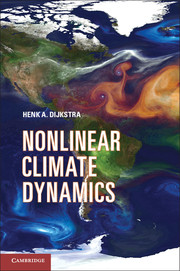Refine search
Actions for selected content:
8126 results in Fluid dynamics and solid mechanics
12 - Predictability
-
- Book:
- Nonlinear Climate Dynamics
- Published online:
- 05 June 2013
- Print publication:
- 17 June 2013, pp 301-336
-
- Chapter
- Export citation
Frontmatter
-
- Book:
- Nonlinear Climate Dynamics
- Published online:
- 05 June 2013
- Print publication:
- 17 June 2013, pp i-iv
-
- Chapter
- Export citation
6 - The Climate Modelling Hierarchy
-
- Book:
- Nonlinear Climate Dynamics
- Published online:
- 05 June 2013
- Print publication:
- 17 June 2013, pp 116-130
-
- Chapter
- Export citation
3 - Introduction to Stochastic Calculus
-
- Book:
- Nonlinear Climate Dynamics
- Published online:
- 05 June 2013
- Print publication:
- 17 June 2013, pp 35-63
-
- Chapter
- Export citation
11 - The Pleistocene Ice Ages
-
- Book:
- Nonlinear Climate Dynamics
- Published online:
- 05 June 2013
- Print publication:
- 17 June 2013, pp 270-300
-
- Chapter
- Export citation
7 - The North Atlantic Oscillation
-
- Book:
- Nonlinear Climate Dynamics
- Published online:
- 05 June 2013
- Print publication:
- 17 June 2013, pp 131-166
-
- Chapter
- Export citation
1 - Climate Variability
-
- Book:
- Nonlinear Climate Dynamics
- Published online:
- 05 June 2013
- Print publication:
- 17 June 2013, pp 1-10
-
- Chapter
- Export citation
9 - Multidecadal Variability
-
- Book:
- Nonlinear Climate Dynamics
- Published online:
- 05 June 2013
- Print publication:
- 17 June 2013, pp 202-230
-
- Chapter
- Export citation
CORRECTION TO “QUASI-MONTE CARLO METHODS FOR HIGH-DIMENSIONAL INTEGRATION: THE STANDARD (WEIGHTED HILBERT SPACE) SETTING AND BEYOND”
-
- Journal:
- The ANZIAM Journal / Volume 54 / Issue 3 / January 2013
- Published online by Cambridge University Press:
- 12 June 2013, pp. 216-219
-
- Article
-
- You have access
- Export citation
AN IMPROVED SECOND-ORDER NUMERICAL METHOD FOR THE GENERALIZED BURGERS–FISHER EQUATION
- Part of
-
- Journal:
- The ANZIAM Journal / Volume 54 / Issue 3 / January 2013
- Published online by Cambridge University Press:
- 12 June 2013, pp. 181-199
-
- Article
-
- You have access
- Export citation
NONLINEAR WAVE EQUATIONS AND REACTION–DIFFUSION EQUATIONS WITH SEVERAL NONLINEAR SOURCE TERMS OF DIFFERENT SIGNS AT HIGH ENERGY LEVEL
- Part of
-
- Journal:
- The ANZIAM Journal / Volume 54 / Issue 3 / January 2013
- Published online by Cambridge University Press:
- 11 June 2013, pp. 153-170
-
- Article
-
- You have access
- Export citation

Fundamentals of Engineering Plasticity
-
- Published online:
- 05 June 2013
- Print publication:
- 22 July 2013

Nonlinear Climate Dynamics
-
- Published online:
- 05 June 2013
- Print publication:
- 17 June 2013
ANZ VOLUME 54 ISSUE 1-2 COVER AND FRONT MATTER
-
- Journal:
- The ANZIAM Journal / Volume 54 / Issue 1-2 / October 2012
- Published online by Cambridge University Press:
- 09 May 2013, pp. f1-f2
-
- Article
-
- You have access
- Export citation
EDITORIAL: INFECTIOUS DISEASE MODELLING
-
- Journal:
- The ANZIAM Journal / Volume 54 / Issue 1-2 / October 2012
- Published online by Cambridge University Press:
- 09 May 2013, pp. 1-2
-
- Article
-
- You have access
- Export citation
ANZ VOLUME 54 ISSUE 1-2 COVER AND BACK MATTER
-
- Journal:
- The ANZIAM Journal / Volume 54 / Issue 1-2 / October 2012
- Published online by Cambridge University Press:
- 09 May 2013, pp. b1-b7
-
- Article
-
- You have access
- Export citation
CALCULUS FROM THE PAST: MULTIPLE DELAY SYSTEMS ARISING IN CANCER CELL MODELLING
- Part of
-
- Journal:
- The ANZIAM Journal / Volume 54 / Issue 3 / January 2013
- Published online by Cambridge University Press:
- 30 April 2013, pp. 117-126
-
- Article
-
- You have access
- Export citation
CRITICAL TIMESCALES AND TIME INTERVALS FOR COUPLED LINEAR PROCESSES
- Part of
-
- Journal:
- The ANZIAM Journal / Volume 54 / Issue 3 / January 2013
- Published online by Cambridge University Press:
- 22 April 2013, pp. 127-142
-
- Article
-
- You have access
- Export citation
A MODIFIED PROJECTED CONJUGATE GRADIENT ALGORITHM FOR UNCONSTRAINED OPTIMIZATION PROBLEMS
- Part of
-
- Journal:
- The ANZIAM Journal / Volume 54 / Issue 3 / January 2013
- Published online by Cambridge University Press:
- 09 April 2013, pp. 143-152
-
- Article
-
- You have access
- Export citation
SPATIAL HETEROGENEITY IN SIMPLE DETERMINISTIC SIR MODELS ASSESSED ECOLOGICALLY
- Part of
-
- Journal:
- The ANZIAM Journal / Volume 54 / Issue 1-2 / October 2012
- Published online by Cambridge University Press:
- 09 April 2013, pp. 23-36
-
- Article
-
- You have access
- Export citation
